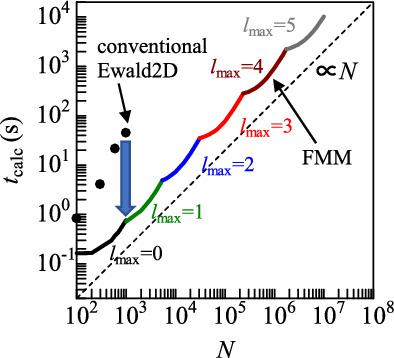当前位置:
X-MOL 学术
›
J. Comput. Chem.
›
论文详情
Our official English website, www.x-mol.net, welcomes your
feedback! (Note: you will need to create a separate account there.)
Fast multipole method for three‐dimensional systems with periodic boundary condition in two directions
Journal of Computational Chemistry ( IF 3.4 ) Pub Date : 2020-01-12 , DOI: 10.1002/jcc.26141 Noriyuki Yoshii 1, 2 , Yoshimichi Andoh 1 , Susumu Okazaki 1, 2
Journal of Computational Chemistry ( IF 3.4 ) Pub Date : 2020-01-12 , DOI: 10.1002/jcc.26141 Noriyuki Yoshii 1, 2 , Yoshimichi Andoh 1 , Susumu Okazaki 1, 2
Affiliation

|
We derived a new expression for the electrostatic interaction of three‐dimensional charge‐neutral systems with two‐dimensional periodic boundary conditions (slab geometry) using a fast multipole method (FMM). Contributions from all the image cells are expressed as a sum of real and reciprocal space terms, and a self‐interaction term. The reciprocal space contribution consists of two parts: zero and nonzero terms of the absolute value of the reciprocal lattice vector. To test the new expressions, electrostatic interactions were calculated for a randomly placed charge distribution in a cubic box and liquid water produced by molecular dynamics calculation. The accuracy could be controlled by the degree of expansion of the FMM. In the present expression, the computational complexity of the electrostatic interaction of N‐particle systems is order N, which is superior to that of the conventional two‐dimensional periodic Ewald method for a slab geometry and the particle mesh Ewald method with a large empty space at an interface of the unit cell. © 2020 Wiley Periodicals, Inc.
中文翻译:

二维具有周期性边界条件的三维系统的快速多极方法
我们使用快速多极法 (FMM) 推导出了具有二维周期性边界条件(板坯几何)的三维电荷-中性系统的静电相互作用的新表达式。来自所有图像单元的贡献表示为实数和倒数空间项的总和,以及一个自交互项。倒易空间贡献由两部分组成:倒易格向量绝对值的零项和非零项。为了测试新表达式,我们计算了立方体中随机放置的电荷分布和通过分子动力学计算产生的液态水的静电相互作用。精度可以通过 FMM 的扩展程度来控制。在本表达式中,N 粒子系统静电相互作用的计算复杂度为 N 阶,这优于传统的二维周期 Ewald 方法用于平板几何和粒子网格 Ewald 方法在晶胞界面处具有大的空白空间。© 2020 威利期刊公司。
更新日期:2020-01-12
中文翻译:

二维具有周期性边界条件的三维系统的快速多极方法
我们使用快速多极法 (FMM) 推导出了具有二维周期性边界条件(板坯几何)的三维电荷-中性系统的静电相互作用的新表达式。来自所有图像单元的贡献表示为实数和倒数空间项的总和,以及一个自交互项。倒易空间贡献由两部分组成:倒易格向量绝对值的零项和非零项。为了测试新表达式,我们计算了立方体中随机放置的电荷分布和通过分子动力学计算产生的液态水的静电相互作用。精度可以通过 FMM 的扩展程度来控制。在本表达式中,N 粒子系统静电相互作用的计算复杂度为 N 阶,这优于传统的二维周期 Ewald 方法用于平板几何和粒子网格 Ewald 方法在晶胞界面处具有大的空白空间。© 2020 威利期刊公司。











































 京公网安备 11010802027423号
京公网安备 11010802027423号